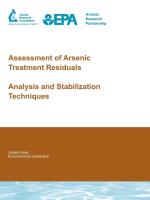Assessment of Arsenic Treatment Residuals: Analysis and Stabilization Techniques
BücherAngebote / Angebote:
The recent reduction in the maximum allowable contaminant level for arsenic in municipal drinking water has increased the need for effective strategies to remove arsenic from drinking water and has led to the increased generation of arsenic-contaminated residuals from water treatment systems. Arsenic is commonly removed by adsorption onto oxides or hydroxides of iron or aluminum. These materials must be disposed of in a manner that ensures that the arsenic will not be released after disposal.
The objectives of this research were to (1) conduct a general physical and chemical characterization of arsenic-contaminated residuals generated in the laboratory and at operating water utilities, (2) evaluate environmental and chemical factors impacting the release of arsenic from residuals, and (3) evaluate methods to stabilize arsenic against release from a variety of residual materials.
The release of arsenic from water treatment residuals was lower from iron-based residuals compared to aluminum-based residuals or residuals produced by lime/soda ash treatment. Arsenic release was determined by residual composition and predominant arsenic species, but was also highly impacted by pH, counter-ion, and the presence of competing ligands. More favorable arsenic retention was generally achieved with iron-based residuals, with arsenate compared to arsenite, and at pH values approaching neutrality. Increasing desorption of arsenate was observed at pH values greater than 8, however, this pH effect could be largely eliminated with calcium instead of sodium as the counter-ion.
Folgt in ca. 15 Arbeitstagen

